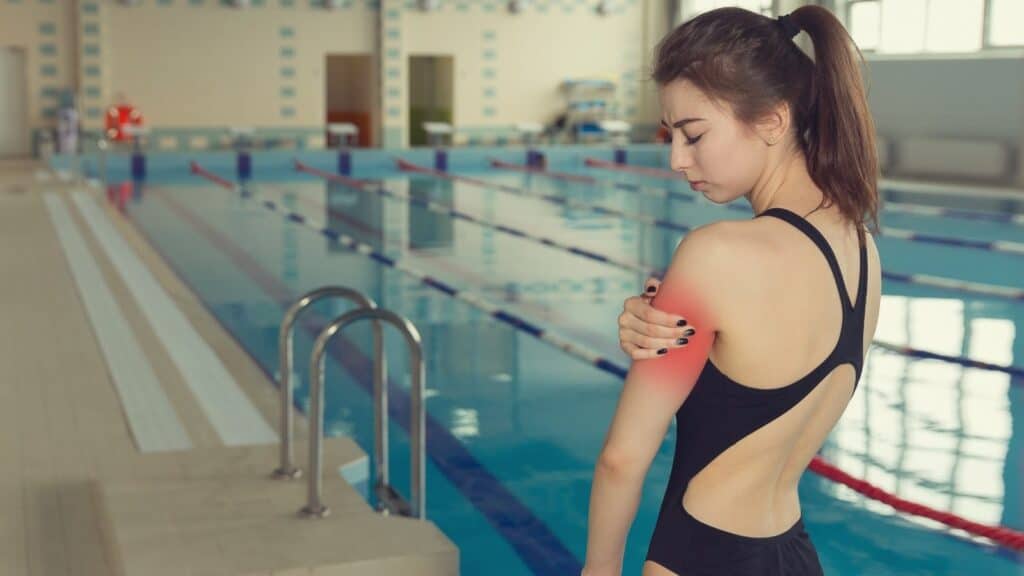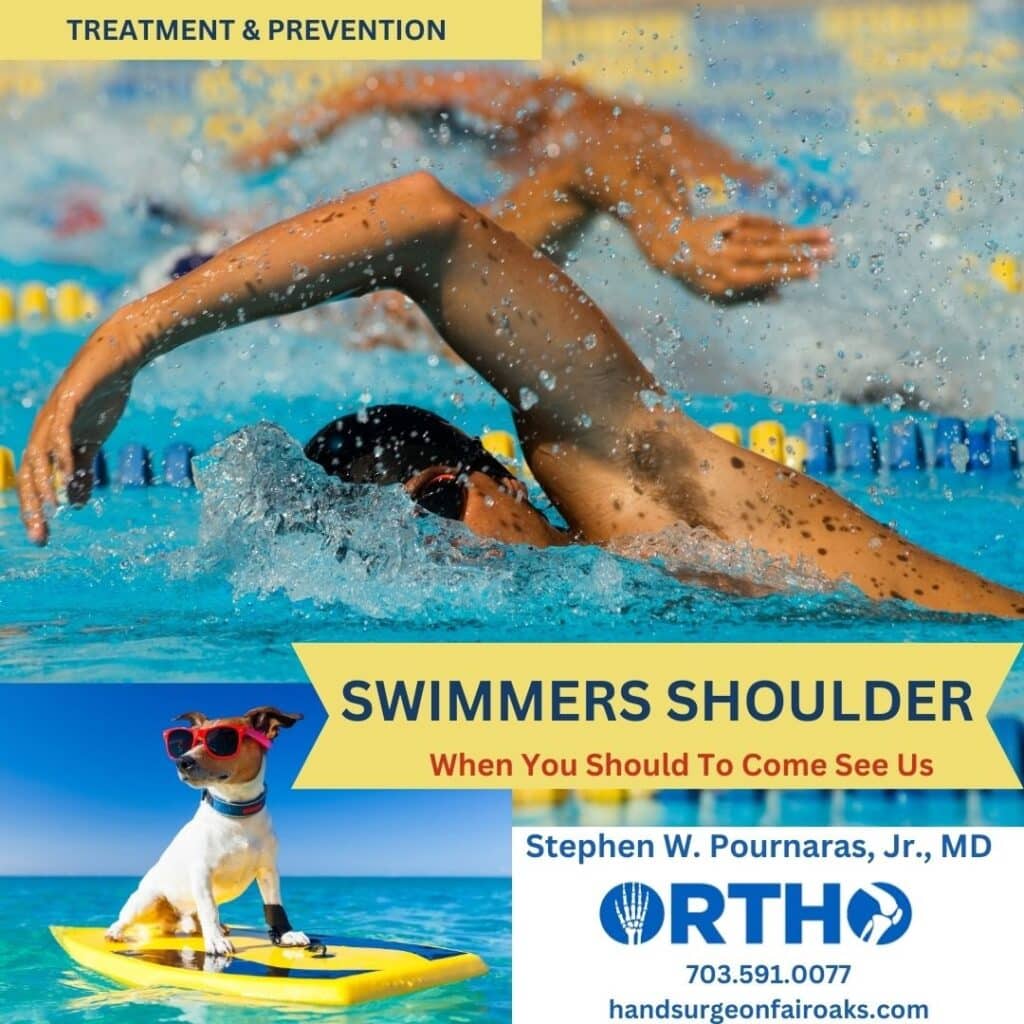This website uses cookies so that we can provide you with the best user experience possible. Cookie information is stored in your browser and performs functions such as recognising you when you return to our website and helping our team to understand which sections of the website you find most interesting and useful.

If you are having trouble moving your shoulder and feeling pain that travels from your front to your back, or if you are noticing changes in your daily shoulder muscle function, you could have swimmer’s shoulder.
Shoulder impingement syndrome (SIS), also known as subacromial impingement syndrome, is a common cause of shoulder pain and dysfunction. It occurs when the structures within the shoulder joint become compressed or irritated, particularly the tendons of the rotator cuff and the subacromial bursa, as they pass through the narrow space beneath the acromion (a bony projection of the scapula or shoulder blade) and the coracoacromial arch.

It’s essential for patients with shoulder conditions or injuries to work closely with our Orthopedic team to ensure they follow a comprehensive treatment plan that meets their specific medical needs and goals.
Swimmer’s shoulder, also known as shoulder impingement syndrome or subacromial impingement syndrome, is a common overuse injury that affects swimmers and patients who engage in repetitive overhead activities. It refers to a variety of shoulder problems characterized by pain, inflammation, and dysfunction in the shoulder joint, particularly in the structures around the rotator cuff and the subacromial space.
Causes: Swimmer’s shoulder is primarily caused by repetitive overhead movements of the arms, particularly in swimming strokes such as freestyle, butterfly, and backstroke. The repetitive nature of these movements can lead to excessive stress and strain on the tendons, muscles, and other structures around the shoulder joint. Over time, this can result in irritation, inflammation, and microtrauma, contributing to the development of the swimmer’s shoulder.
Mechanism: During swimming, the shoulder joint undergoes repetitive and forceful movements, including internal rotation, abduction, and overhead arm elevation. These movements can lead to impingement of the tendons of the rotator cuff and the subacromial bursa as they pass through the narrow space beneath the acromion (a bony projection of the scapula or shoulder blade) and the coracoacromial arch. This impingement can cause compression, friction, and irritation of the soft tissues, leading to pain and dysfunction in the shoulder joint.
Shoulder Impingement Syndrome (SIS) is a common problem among swimmers and patients who engage in repetitive overhead activities. Our medical team can evaluate and appropriately treat the shoulder to alleviate symptoms, prevent the condition from progressing, and assist in the recovery. Additionally, proper swimming technique, warm-up exercises, and conditioning programs recommended by our therapists can help reduce the risk of developing a swimmer’s shoulder.
If you are experiencing swimmers shoulder and need medical care, please contact Dr. Stephen W. Pournaras and our professional medical staff can help you recover by simply contacting us today.
Yes, there are different types of shoulder injuries commonly associated with swimming, referred to as “swimmer’s shoulder.”
These injuries can vary in severity and location within the shoulder complex. Some common types include:
Rotator Cuff Tendinitis: This is one of swimmers’ most common shoulder injuries. It involves inflammation or irritation of the tendons of the rotator cuff muscles, which help stabilize the shoulder joint during swimming strokes.
Rotator Cuff Tears: Overuse or trauma can lead to tears in the rotator cuff muscles or tendons. These tears can range from minor to severe and may require medical attention.
Impingement Syndrome: This occurs when the tendons of the rotator cuff and the bursa (fluid-filled sac) within the shoulder become pinched or compressed, typically during overhead movements like swimming strokes.
Labral Tears: The labrum is a cartilage ring that surrounds the shoulder joint socket, providing stability. Tears in the labrum can result from repetitive stress on the shoulder joint during swimming.
Biceps Tendinitis: Inflammation of the biceps tendon, which attaches the biceps muscle to the shoulder, can cause pain and discomfort in the front of the shoulder.
Shoulder Instability: Swimmers may experience shoulder instability due to repetitive overhead motions, leading to looseness or laxity in the shoulder. This instability can result in pain, weakness, and a feeling of the shoulder “slipping” or “catching” during swimming.
Shoulder Bursitis: Inflammation of the bursa within the shoulder can occur due to overuse or repetitive stress, leading to pain and swelling.
To help prevent shoulder injuries, swimmers must practice proper technique, warm up adequately before swimming, and incorporate strength and flexibility exercises. If shoulder pain or discomfort arises, it’s crucial to rest, ice the affected area, and call our medical team to prevent further damage and promote proper healing.
Symptoms of a Swimmer’s Shoulder:
Pain in the shoulder is the most common symptom of a swimmer’s shoulder. It may be felt during swimming, particularly during specific strokes or movements, and can also occur at rest. The pain may be sharp, dull, or achy and may worsen with certain activities or movements.
Tenderness: The affected area of the shoulder may be tender to the touch. Pressing on or around the shoulder may elicit pain or discomfort.
Weakness: Swimmer’s shoulder can lead to weakness in the shoulder muscles, which may affect swimming performance and other activities that involve the use of the arms and shoulders.
Limited Range of Motion: There may be a decrease in the shoulder’s range of motion, particularly with overhead movements or reaching across the body. This limitation in mobility can impact swimming technique and daily activities.
Swelling: Inflammation of the shoulder or surrounding tissues can cause swelling, which may be visible or palpable around the shoulder area.
Popping or Clicking Sensation: Some patients with swimmer’s shoulder may experience popping, clicking, or catching sensation in the shoulder during certain movements.
Stiffness: The shoulder may feel stiff or tight, especially after periods of inactivity or rest.
Radiating Pain: In some cases, shoulder pain associated with swimmer’s shoulder may radiate down the arm or into the neck.
It’s essential to pay attention to these symptoms and call our medical team if they persist or worsen over time. Early diagnosis and treatment can help prevent further injury and promote a quicker recovery.
Treatment for swimmer’s shoulder involves a combination of rest, physical therapy, pain management, and lifestyle modifications.
Rest: Resting the shoulder is essential to allow the injured tissues to heal. Avoiding activities that exacerbate pain or discomfort, including swimming, can help prevent further shoulder irritation.
Ice: Applying ice to the shoulder for 15-20 minutes several times a day can help reduce pain and inflammation. Use a cold pack or ice wrapped in a towel to avoid direct contact with the skin.
Pain Management: Over-the-counter pain medications such as ibuprofen or acetaminophen may help alleviate pain and discomfort associated with swimmer’s shoulder.
Physical Therapy: One of our physical therapists can develop a customized exercise program to strengthen the muscles surrounding the shoulder joint, improve flexibility, and correct any biomechanical issues contributing to the injury. Physical therapy may include stretching exercises, strengthening exercises, manual therapy techniques, and modalities such as ultrasound or electrical stimulation.
Activity Modification: Modifying swimming techniques or avoiding specific strokes that aggravate the shoulder can help prevent further injury and promote healing. A swim coach or physical therapist can guide proper technique and modifications to reduce stress on the shoulder joint.
Posture Correction: Poor posture can contribute to shoulder pain and dysfunction. Improving posture through exercises and ergonomic modifications can help alleviate strain on the shoulder joint and prevent future injuries.
Cross-Training: Engaging in low-impact activities such as cycling, walking, or using an elliptical machine can help maintain cardiovascular fitness while giving the shoulder time to heal. Be sure to choose activities that do not aggravate the shoulder.
Bracing or Taping: A shoulder brace or kinesiology tape may support the shoulder joint and help alleviate pain during activities. A healthcare professional can recommend the appropriate brace or taping technique based on the patient’s injury and needs.
Injections: In some cases, corticosteroid injections may be recommended to reduce inflammation and pain in the shoulder joint. However, these injections are typically used as a short-term solution and may not address the underlying cause of the injury.
Surgery: In severe cases of swimmer’s shoulder that do not respond to conservative treatments, surgery may be considered. Surgical options may include arthroscopic procedures to repair damaged tissues or stabilize the shoulder joint.
It’s really important for patients with swimmer’s shoulder to follow our medical team’s instructions for their treatment plan to promote healing and prevent the recurrence of the injury.
Surgery for a swimmer’s shoulder is typically considered when non-surgical treatments have failed to help with symptoms and when there is significant damage to the shoulder structures that cannot be addressed through non-surgical means.
Common surgical options for swimmer’s shoulder:
Arthroscopic Debridement: This minimally invasive procedure involves using small incisions and a tiny camera (arthroscope) to visualize the inside of the shoulder joint. The damaged tissue, such as inflamed bursa, frayed tendons, or loose cartilage, can be removed to reduce pain and improve shoulder function.
Rotator Cuff Repair: If there is a partial or complete tear in one or more of the rotator cuff tendons, surgery may be necessary to reattach the tendon(s) to the bone. This can be done using arthroscopic techniques or an open surgical approach, depending on the extent of the injury.
Labral Repair: Tears or damage to the labrum, the cartilage ring surrounding the shoulder socket, may require surgical repair. Dr. Pournaras can reattach the torn labrum to the shoulder socket using sutures or anchors, either arthroscopically or through an open procedure.
Shoulder Impingement Surgery: In cases of severe impingement syndrome that do not respond to conservative treatments, surgery may be performed to create more space within the shoulder joint. This can involve removing a small portion of the acromion (the bony projection on the shoulder blade) or the bony prominence on the collarbone (clavicle) end to alleviate pressure on the rotator cuff tendons.
Capsular Release: For patients with shoulder stiffness or adhesive capsulitis (frozen shoulder) secondary to swimmer’s shoulder, a surgical procedure called capsular release may be performed. This involves cutting through tight or thickened portions of the joint capsule to improve range of motion and reduce stiffness.
Shoulder Stabilization: In cases of shoulder instability or recurrent dislocations, surgical stabilization procedures may be necessary to tighten and reinforce the ligaments and soft tissues surrounding the shoulder joint.
Biceps Tenodesis: If the biceps tendon is damaged or inflamed and cannot be addressed through conservative measures, the surgeon may perform a biceps tenodesis. This involves detaching the damaged portion of the biceps tendon and reattaching it to a different location on the humerus (upper arm bone).
The specific surgical approach chosen will depend on the patient’s condition, the extent of the injury, and other factors such as age, activity level, and overall health. Physical therapy is crucial to postoperative rehabilitation to optimize shoulder function and prevent complications.
Make Your Appointment Today
Fair Oaks Ortho – Fairfax,VA




